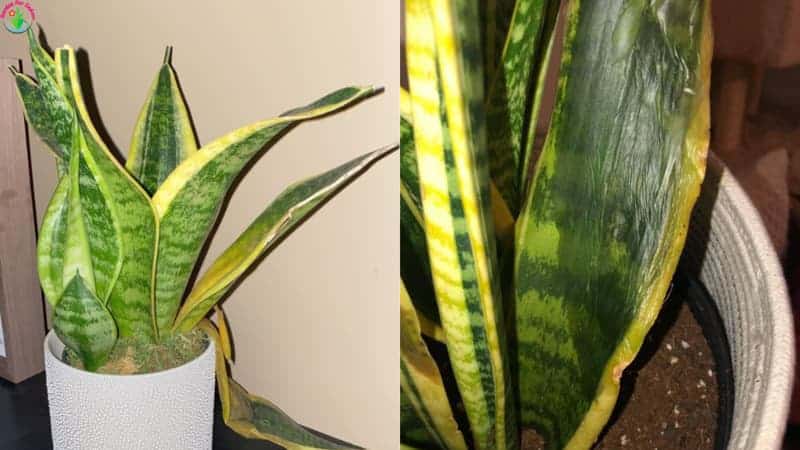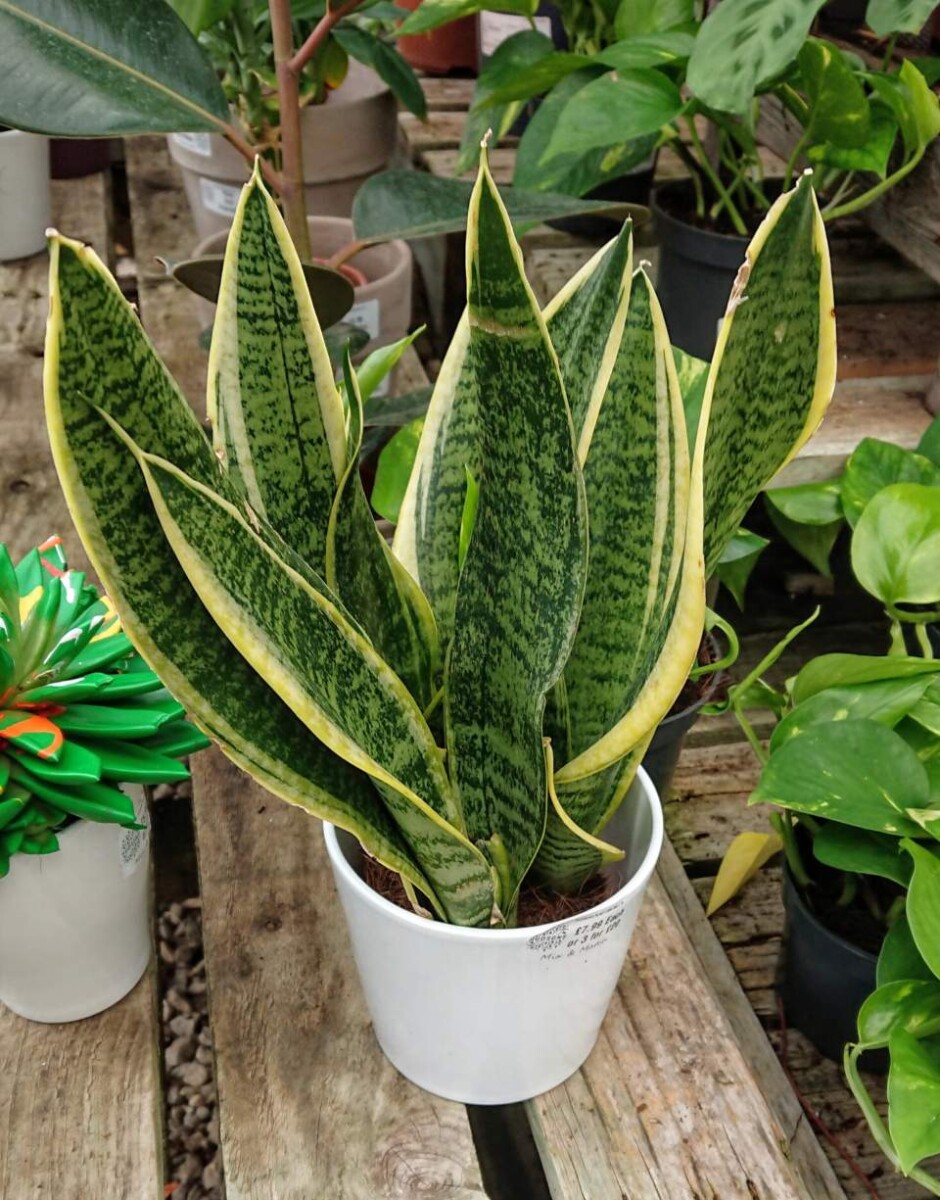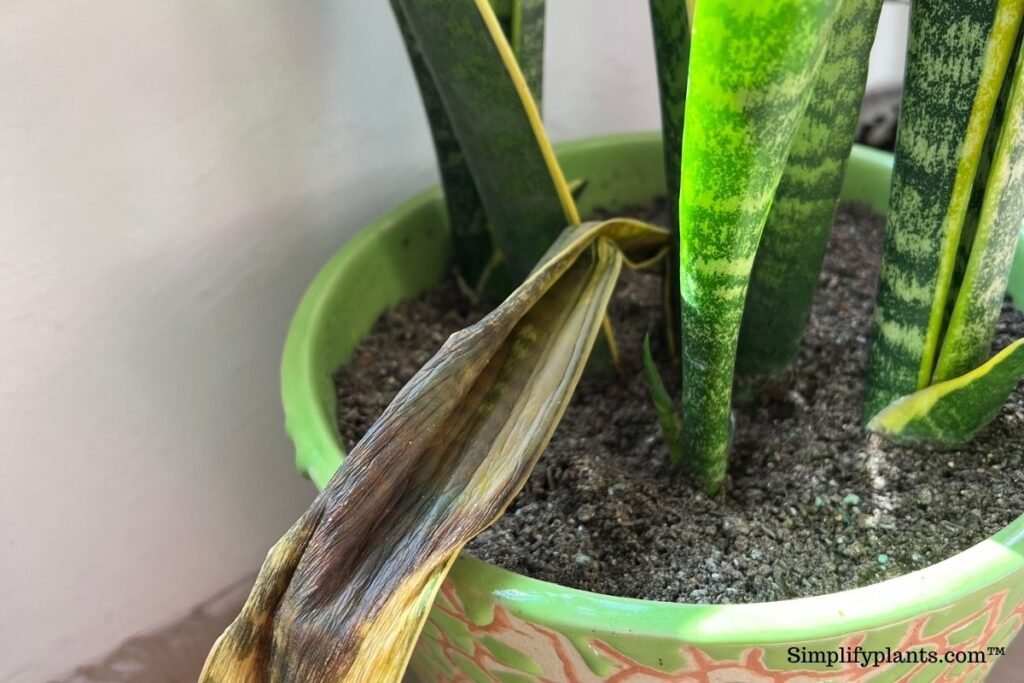
Overwatering and poorly draining soils are the main causes of dying snake plants, which result in its leaves turning brown or yellow and drooping. Snake plants cannot survive in the cold and will perish at temps below 50°F.
A dying snake plant needs to be placed in an area with brilliant indirect light rather than direct sunlight, well watered, and in a room that is warmer than 50°F in order to mimic some of the circumstances of its natural habitat.
Read on to learn how to recover. Your snake plant’s leaves may have curled inward and developed white spots owing to underwatering or cold stress, or they may have gone yellow or brown and appeared to be drooping as a result of overwatering…
Table of Contents
Snake Plant Turning Yellow or Brown and Drooping
- Symptoms. Snake plant leaves begin to yellow, potentially droop, and change from being hard to having a mushy texture.
- Causes. excessive soil moisture, sluggish drainage, and improper drainage in containers.
A drought-resistant succulent called a snake plant has evolved to flourish in the arid, sandy soil, infrequent rainfall, and low humidity of tropical Africa.
This drought-resistant plant cannot handle excessive moisture around the roots, which can be caused by overwatering snake plants or by placing them in potting soil that is left damp for an extended period of time.
Snake plants experience stress when there is too much moisture around the roots, which causes their leaves to turn yellow or brown and become mushy.
As a result, snake plants need to be watered less frequently than the majority of house plants and need a soil that drains far more quickly than regular potting soil.
Use a gritty or sandy, well-draining potting mix and water only after the soil has completely dried out to mimic some of the characteristics of the plant’s native environment in order to effectively grow snake plants and prevent the leaves from becoming yellow or brown.
The snake plant’s leaves turn yellow with drooping leaves if the soil is not allowed to dry out between watering sessions. Severe cases can result in root rot and the snake plant dying back because this is against the conditions to which it has been accustomed.
Additionally, it’s crucial that snake plants be grown in containers with drainage holes at the bottom that allow water to flow freely.
Extra water frequently pools around the roots of potted plants on saucers and trays underneath, giving the plants a dead appearance.
(Read my post on how to water snake plants to understand about the best strategies for doing so.)
How to Revive a Snake Plant with Yellow or Brown Drooping Leaves

Feel the dirt at the bottom of the pot via the drainage hole in the base to determine how frequently to water snake plants. If the soil seems wet, wait a few days before watering; however, if the soil feels dry, now is the ideal time to water.
By watering snake plants according to this schedule, you may simulate the regular watering cycle that occurs in their natural environment—heavy rainfall followed by a dry spell.
The appropriate watering cycle for your home should be established by feeling the soil to see when it is dry. Snake plants typically need watering once every two weeks, but this might vary depending on the climate and conditions in your home.
Always check the drainage hole in the base of the pot to make sure nothing is blocking it with compacted soil or roots that could hinder drainage.
The snake plant can recover without being stressed once the dirt surrounding its roots has had time to totally dry up, you’ve changed how frequently you water, or the soil has been replaced if it was sluggish draining.
Over the coming weeks, the snake plants should start to show indications of recovering.
Cut back these severely harmed leaves at the base of the plant if the brown or yellow color is still spreading and the leaf feels squishy since those particular leaves are unlikely to recover and this can stop rot from spreading to other areas of the plant.
A snake plant with bad root rot…
Even with the finest care, root rot can still cause snake plant leaves to become increasingly discolored, at which time it may be impossible to rescue the plant.
As the rest of the plant may die back, the best course of action is to take cuttings of any healthy remaining leaves for propagation.
Cuttings from snake plant leaves can easily be multiplied to create new plants, which may be the only chance you have to save your plant.
Watch this instructive YouTube video to learn how to quickly grow additional snake plants from leaf cuttings at no additional cost:
(To find out why your snake plant is becoming black, see my post.)
Snake Plant Leaves Curling
- Snake plant leaves curling inward, maybe splitting or looking wrinkled are the symptoms.
- Causes. harm from cold, hydrophobic soil, or underwatering.
If the leaves of your snake plant are curling inward, the plant is either underwatered or has undergone cold damage.
In times of drought stress, snake plants utilize up the water they have stored in their leaves, which causes the leaves to coil inward.
Unwatered leaves can occasionally appear split or even wrinkled at the base of the leaf.
This may occur as a result of the misconception that “snake plants do not need much water,” which leads some people to believe that the plant need only be watered sparingly rather than infrequently.
Although snake plants are drought-resistant and can survive for two to three weeks without water, they still need a good soak each time, which is then stored in the leaves as a drought-resistance technique.
Some soil mixtures bake hard when they dry out, which is another possible explanation for why leaves curl inward.
When the soil is dry, it can keep water from sticking to the surface, allowing it to drain out of the drainage holes and down the side of the pot.
This may give the snake plant the appearance of having received a lot of water, but the water may not have adequately soaked into the soil, preventing the roots from drawing in moisture and leading to the drought symptoms of curled leaves.
Cold Damage Causes Leaves to Curl
Because they are tropical plants, snake plants cannot withstand cold or freezing conditions.
The ideal temperature range for growing snake plants is between 50°F (10°C) and (23°C) 75°F. Their initial response when placed in a room that drops significantly below this temperature is to coil as a sign of stress.
If the snake plant is subjected to extreme cold, the leaves will start to become white and mushy one to four weeks after the exposure.
If your snake plant is sitting on a window sill and its leaves come into contact with a cold window, this could happen.
How to Revive a Snake Plant with Curling Leaves
Snake plants with curled leaves under drought stress:
- For ten minutes, submerge the snake plant in a bowl of water. If the soil of the snake plant is keeping water from penetrating below the surface, immersing the root ball for ten minutes enables the roots to absorb desperately needed moisture.
- Always use a lot of water while you soak. If you water your plants too little, the liquid just penetrates the top inch or two of the soil and does not reach the roots. Fill the base with enough water to allow any extra to drain through the drainage holes. This is a reliable indicator of whether you have given the plant enough water to maintain its health.
- Replace the soil if it appears dry underneath your snake plant and water is dripping off the surface. Snake plants should be grown in a particular succulent and cactus soil that closely resembles the permeable, well-draining soils found in their natural habitat. Even when it is dry, the soil for succulents and cacti guarantees optimum water infiltration and does not bake hard like certain potting mixes.
Your drought-stressed snake plant should start to recover in the next week with proper watering techniques and an initial 10-minute soak.
Curled-up leaves can begin to retain water once again and recover to a plump, full texture as opposed to a lifeless appearance.
Reviving Cold Damaged Snake Plants
When placed in a room that is constantly warmer than 50°F (10°C), a snake plant that has been exposed to temps just a little below that mark will recover from its curled appearance.
However, these leaves are unlikely to heal if your snake plant has white patches that feel mushy.
Use a clean pair of pruners to cut the damaged leaf blades back down to the soil to stop the damage from spreading.
Snake Plants With Brown Spots

Although they prefer bright indirect light and can even survive in significant shadow, snake plants can sometimes adapt to full sun.
Snake plants’ development can be slowed by shade. For more on why a snake plant is not growing and possible solutions, see my post.
The snake plant can burn with brown spots on the leaves if it is relocated from a shaded area to any direct sunshine.
The snake plant can survive for a very long time despite sun damage to its leaves, even though the sunburned portions of its leaves do not recover in appearance.
To promote the growth of more healthy leaves, it may be a good idea to trim the damaged leaf blade back to the soil.
Larger-base pots keep the snake plant from toppling over because it can become very top-heavy. If snake plants fall over, they may bruise.
Key Takeaways:
- Since they are tropical plants, snake plants cannot survive in cold or freezing conditions.
- A temperature range of 50°F (10°C) and (23°C) 75°F is necessary for the growth of snake plants. Their initial response is to curl as a sign of stress if they are in a room that drops far below this temperature.
- It takes the snake plant 1-4 weeks to acquire white, mushy regions on its leaves after being exposed to extremely low temperatures.
- This may occur if your snake plant’s leaves come into contact with a frosty window while it is sitting on a window ledge.
